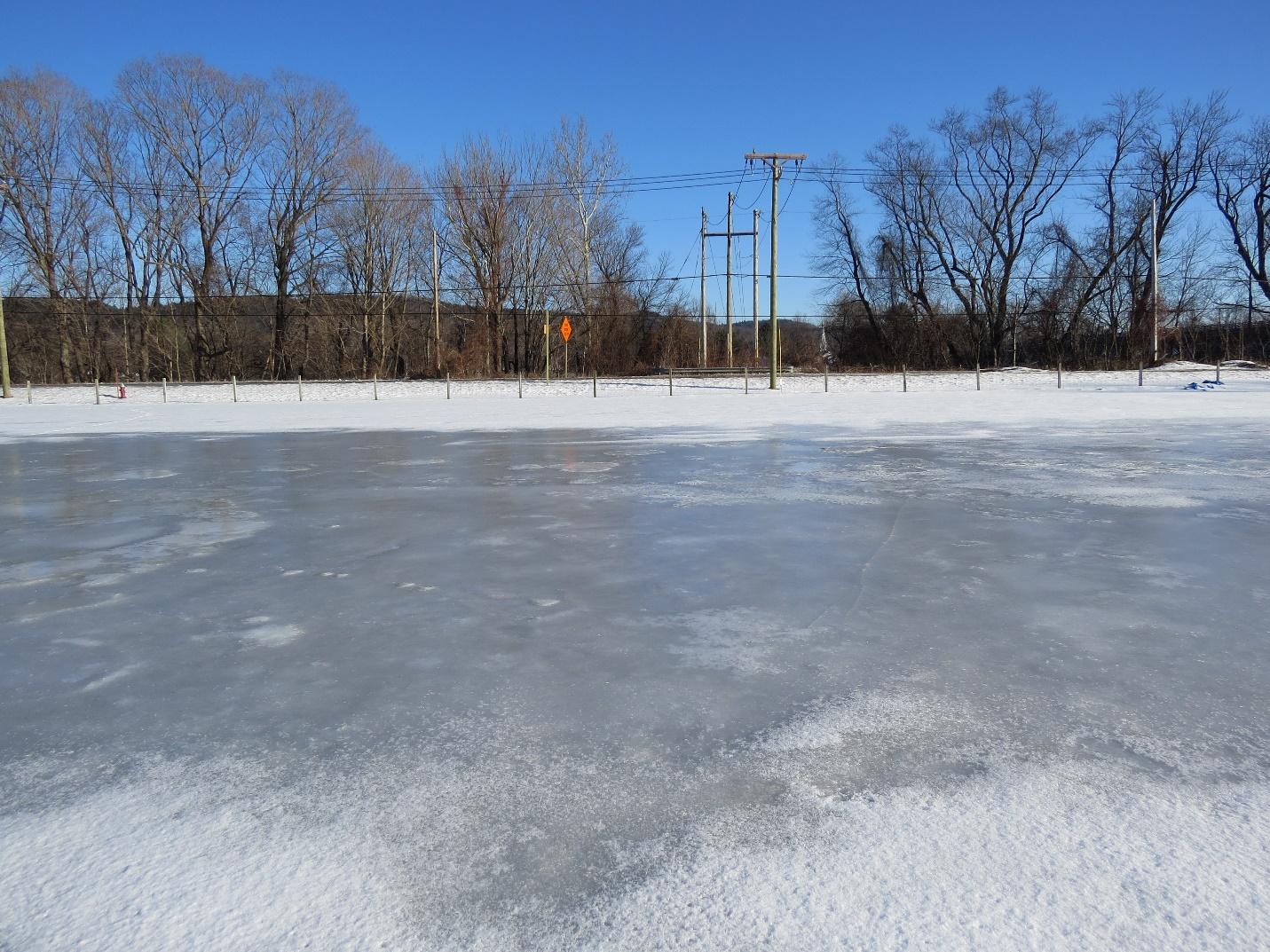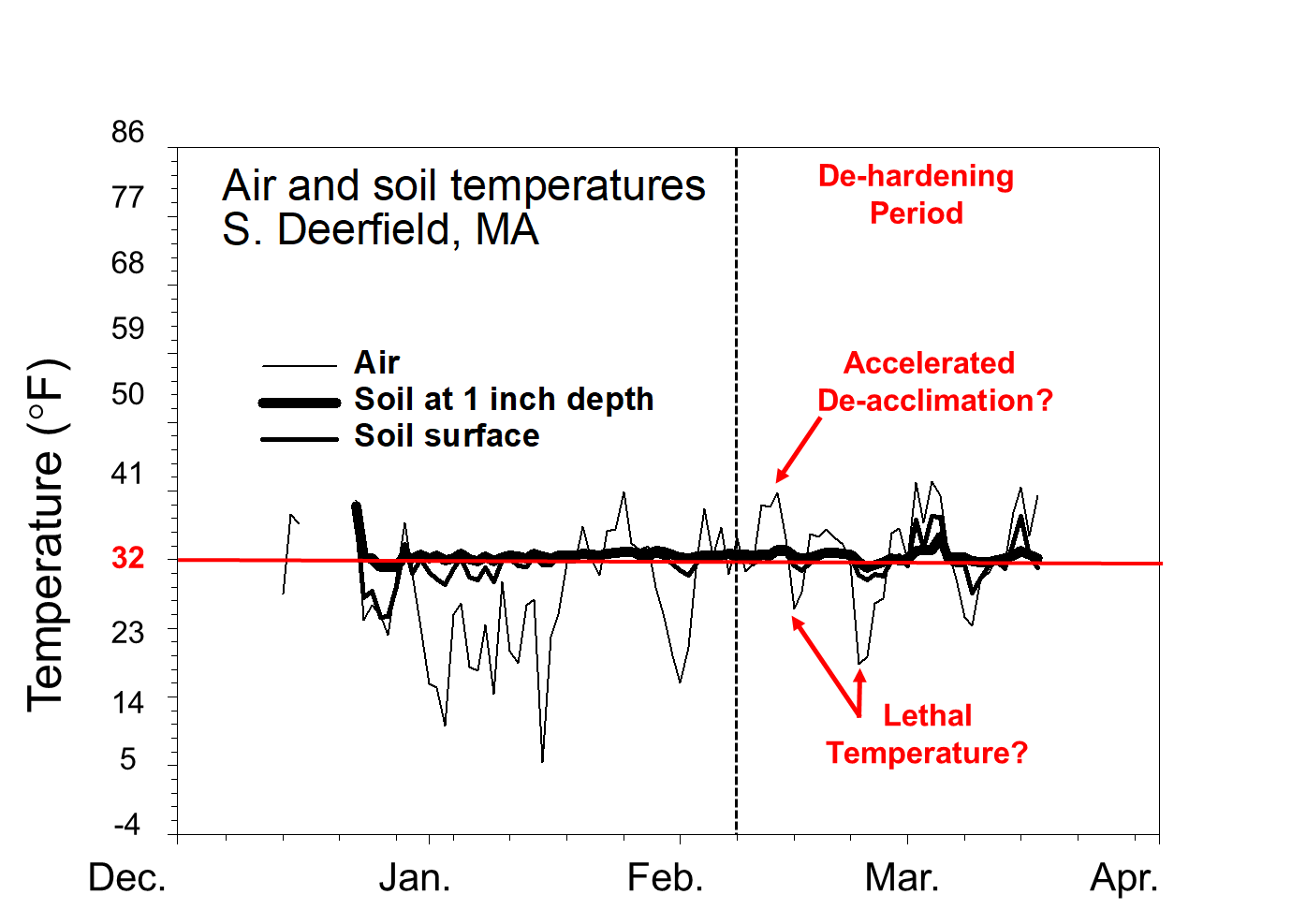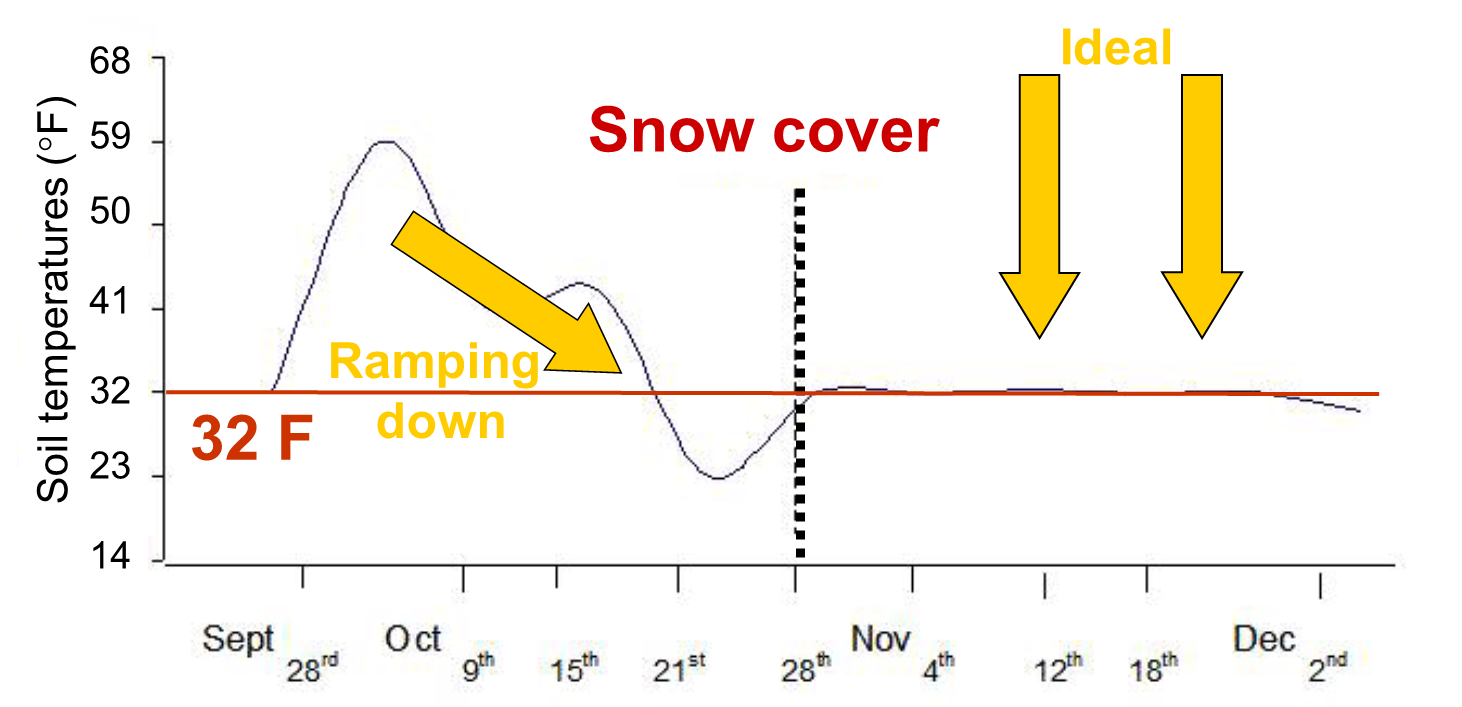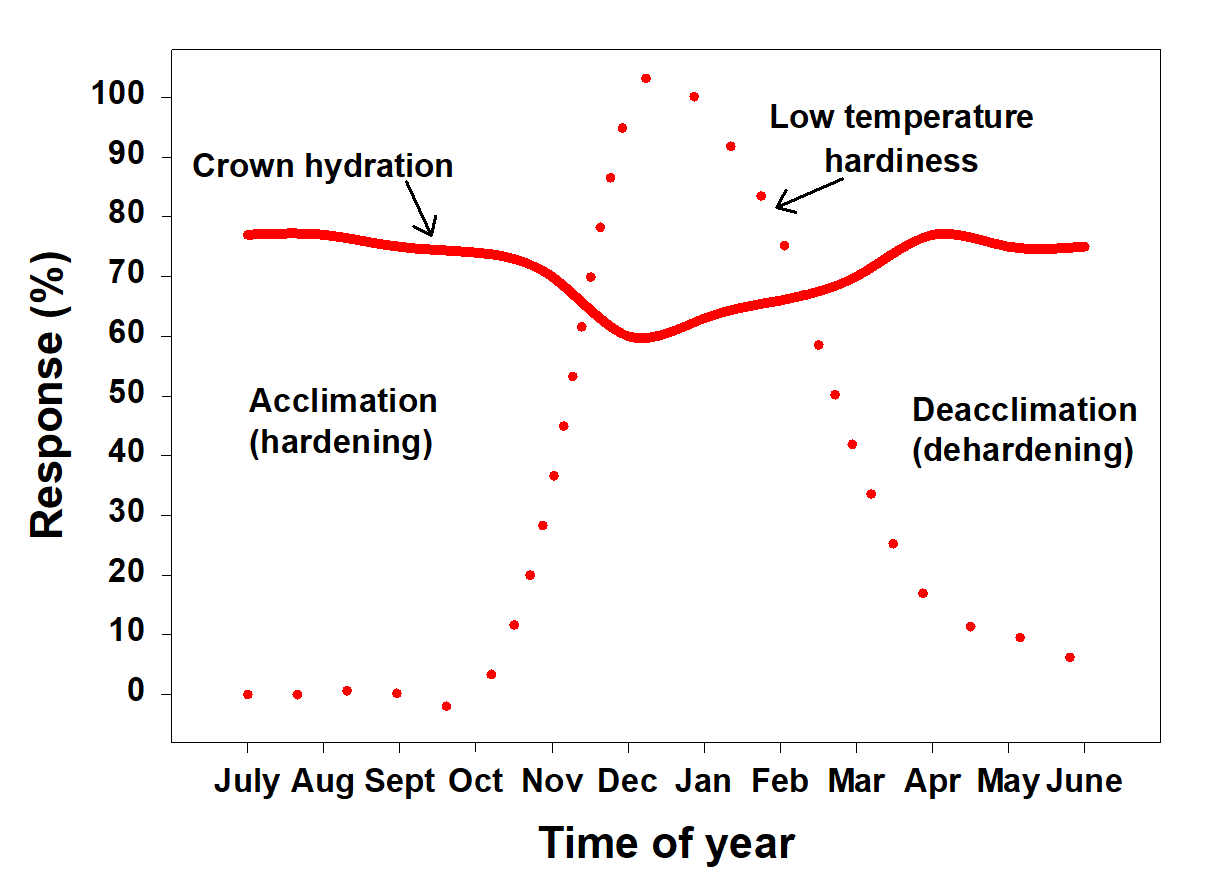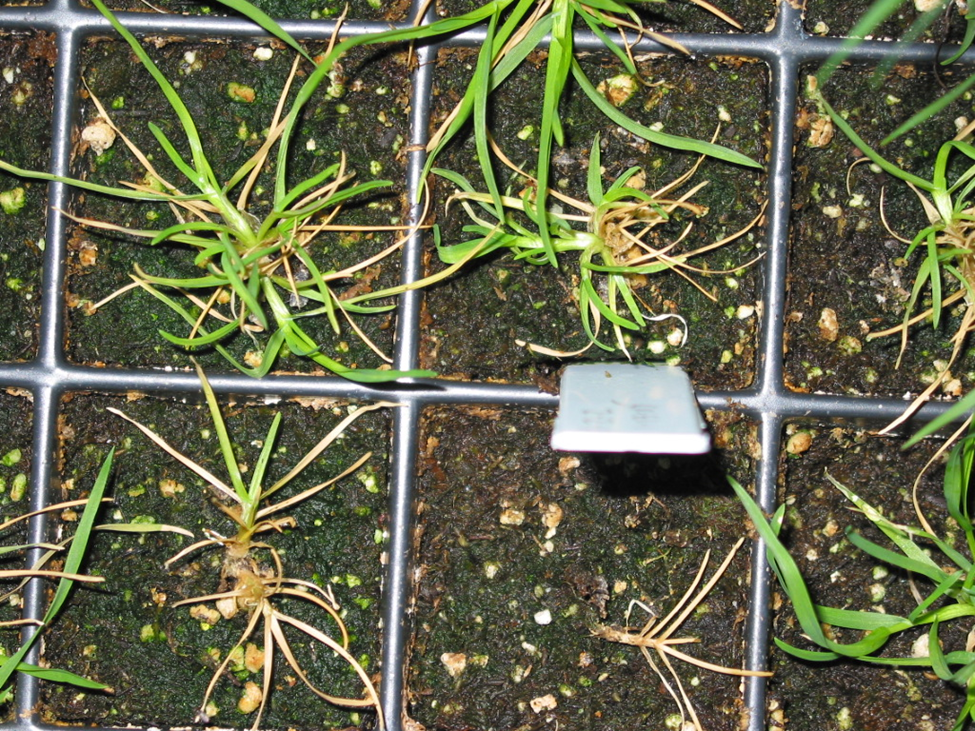Major Winter Injuries of Cool-Season Turfgrass in New England: Understanding, Prevention and Recovery
Management of winter injuries is a major priority in the New England region because 35 to 75% of all maintenance expenses are in the form of preventing or recovery from winter-kill caused by low-temperature (freezing stress) and ice cover (suffocation) injuries or their combination (Rossi, 1999). While other injuries during winter such as snow mold diseases and winter desiccation can be significant, confusion and proper diagnosis of turf damage under the cover of snow and ice can be more difficult.
The diagnosis of winter-kill caused by low-temperature (lethal freezing temperatures) and anoxia (ice encasement-suffocation) are confusing because crown hydration (free water in the plant) are pre-conditions active under both the cover of snow and ice (Photo 1).
Photo 1 (above). Ice cover at the Troll Turf Research & Education Center, South Deerfield, MA, January, 2015.
Often times ice is formed under the cover of snow (Photos 2 and 3) during freezing/thawing in late winter or premature thawing in winter.
Photo 2 (above). Ice cover of approximately 3-inch depth underneath 12-inch cover of snow, Troll Turf Research & Education Center, South Deerfield, MA, March, 2015.
Note the greater (and extensive) winter injury (kill) from low temperature with the cold sensitive perennial ryegrass plots shown below in Photo 3. The more cold hardy species including creeping bentgrass, Kentucky bluegrass, fine fescue, as well as colonial and velvet bentgrass species survived and fully recovered. Annual bluegrass (Poa annua) also suffered injury but recovered. Perennial ryegrass never recovered.
Photo 3. Thawing (left) of the same ice cover shown in Photo 1 followed by winter-kill to perennial ryegrass (right) from freezing stress due to crown hydration.
In the field, increases in crown hydration (crown water) may predispose turfgrass to greater potential to winter-kill from low temperature (Figure 1 below). However, there are no absolute hydration levels under which turfgrass will be killed by freezing temperatures. Greater crown hydration is only an association for the potential of greater low temperature injury and winter-kill from freeze stress.
Figure 1 (above). A 5% differential existed in crown water content (83 to 88%) in this data for perennial ryegrass. Perennial ryegrass tolerance to low temperature decreased by ½ while crown hydration increased by only 5% (from Webster and Ebdon, 2005). LT50s (median lethal temperature at which 50% of the plants are killed) increased from 7.5 F (83% hydration) to 16 F (88% hydration) in perennial ryegrass.
Perennial ryegrass can be killed at much higher temperatures under conditions and practices promoting free water and greater crown hydration. Generally, with soil warming above freezing temperatures in late winter, increase crown water content and diminished cold hardiness occurs (higher LT50s); referred to as “de-hardening” or “de-acclimation” (Figure 2, below).
Figure 2 (above). De-acclimation (loss in cold hardiness) in late winter with perennial ryegrass over a 3-week period in South Deerfield, MA (from Webster and Ebdon, 2005).
Note the siginifcant loss in cold hardiness by the 3rd week (23 February, Figure 2); LT50 temperatures increased from 10.8 to 17.5 ºF. Late winter deacclimation was greater at the 3rd week when compared to the total loss in cold hardiness during the early stages of deacclimation.
Turfgrasses are most susceptible to freezing stress during prolonged periods of freezing (acclimation) and thawing (deacclimation) under the cover of snow and ice. Soil temperarures due to warming during deacclimation (Figure 2) increased from 7.3 ºF (2 February) to 17.5 ºF (23 February) while crown hydration increased little from 84.1% (2 February) to 86.4% (23 February). Only small changes in crown tissue water are needed to affect cold hardiness especially in cold sensitive species such as perennial ryegrass and annual bluegrass (see Figure 3 below).
Figure 3 (above). Relationship between crown moisture and LT50 temperature during deacclimation in early spring on annual bluegrass (from Tompkins et al., 2000).
Similar to perennial ryegrass (Figure 1), only a 5% higher crown moisture differential was associated with large losses in cold hardiness (higher LT50 temperatures) in annual bluegrass (Figure 3). With soil warming in late winter, some turfgrass species like annual bluegrass can de-acclimate (de-harden) quickly and in turn, can be exposed to temperature extremes that are within a susceptible species killing temperatures. As shown in Figure 4 below, soil temperatures are relatively stable during the winter period especially under the cover of snow. Alternatively, crowns that are elevated because of thatch and unprotected from lack of snow cover can be exposed to temperature extremes that are sufficiently cold to cause low temperature kill.
Figure 4 (above). Soil surface temperatures and soil temperatures at 1 inch depth are stable and remain near or at 32 F; which help to prevent deacclimation. Air temperatures are highly variable with temperature extremes sufficient to cuase rapid deacclimation (dehardening) and increase winter-kill to low temperatures.
Figure 5 (above). Slow ramping down of soil temperatures allow turfgrass to establish maximum acclimation (hardening) especially when followed by snow cover on frozen soils to prevent premature deacclimation (from Ross and Tompkins, Prairie Turfgrass Research Center, Canada). Mechanically removing snow or early snow melt can cause early and rapid deacclimation.
Normal hardening in cool-season turfgrass occurs at temperatures of 35 to 45 ºF (2 to 7 ºC) during a 3 to 4-week period of minimal shoot growth (Figures 5 and 6). Physiological hardening involves carbohydrate (CH2O) accumulation and tissue dehydration (lower tissue water). Rapid decline in soil temperature (to below 20 ºF, -7 ºC) during freezing-thawing cycles in mid-winter and late-winter/early-spring favor low temperature kill (Figure 4). Low temperature kill increases with more rapid freezing or thawing events, greater number of freeze/thaw cycles, and the longer the tissue is frozen. Annual bluegrass and perennial ryegrass are less resistant to de-hardening and therefore deacclimate quickly under the cover of ice when compared to other turfgrass species, which promotes higher LT50s (Tompkins et al., 2000; Höglind et al., 2010). Research has also shown that species and cultivars that have the greatest capacity to survive under prolonged ice cover are also some of the cold hardiest species (Höglind et al., 2010).
Figure 6 (above). Graphical representation of acclimation and deacclimation in relationship to cold hardiness and crown hydration (adapted from Beard, 1973).
Practices that increase tissue hydration and decrease CH2O reserves can reduce cold hardiness during acclimation including the following practices and conditions (i) N applied at excess rates, especially during fall acclimation, (ii) inadequate soil K, (iii) inadequate surface/sub-surface drainage, (iv) excessive shade, (v) cold sensitive species and cultivars, (vi) excess thatch, (vii) soil compaction, and (viii) excessively close mowing (especially under shade).
Turfgrass managers that plant cold sensitive species such as perennial ryegrass should consult with university extension professionals and utilize National Turfgrass Evaluation Program (NTEP) test data (if available) to identify the cold hardy cultivars, especially perennial ryegrass. Research has shown that cultivars selected from northern latitudes based on having better turfgrass quality, exhibit superior cold hardiness (Ebdon et al., 2002; Höglind et al., 2010).
Photo 4. Results from winter-kill in 2014 caused by low temperature on a NTEP perennial ryegrass test (left) with survival from cold hardier cultivars (right). Troll Turf Research & Education Center, South Deerfield, MA.
Research has suggested that low temperature pathogens that weaken plants can increase low temperature kill. Therefore, preventative fungicides for the control of snow mold diseases are especially important for low temperature susceptible Poa annua and perennial ryegrass.
Drier fall conditions and drought can enhance low temperature hardiness compared to well-watered conditions, especially in cold sensitive species (Welterlen and Watschke, 1985; Lanier et al., 2012). Irrigate only to prevent desiccation during open (snow free) periods during acclimation. Also, correcting for excessively wet, poorly drained, low areas where ice can form, may alleviate special problems during late winter/early spring when grasses are deacclimating.
Annual bluegrass and perennial ryegrass are not only susceptible to direct low temperature kill but are susceptible to ice cover (encasement/suffocation injuries), see Photo 5 below.
Photo 5. Examples of suffocation injury on perennial ryegrass. Cracks in the ice that were formed in winter allowed for gas exchange and the release of CO2 and uptake of O2. Perennial ryegrass survived in these localized areas under prolonged ice cover (> 75 days). See also photos 1 and 2 as examples of the ice sheet (3-inch depth) that formed causing suffocation injury.
Ice formation can result from water accumulation in low areas, uniform ice build-up from repeated sleet storms, and freezing and thawing of snow cover. Physiological injury caused by ice if sufficiently thick and prolong acts as a physical barrier to gas exchange between soil air and bulk atmospheric air (21% O2 and 0.5% CO2). Clear ice (high density) may impair gaseous exchange more than milky or white ice (low density), however, physical appearance may not be a good indicator of permeability. Lethal agents causing reduction in survival under prolong ice cover may include suffocation (low O2 or anoxia, < 1% O2), accumulation of toxic gases (CO2, > 10%), and depleted CH2O reserves. Specific mechanisms of injury are inconclusive, however, species maintaining higher CH2O reserves under prolong ice cover are associated with greater tolerance to ice duration (Höglind et al., 2010).
Low temperature kill can result from freezing and thawing under ice, followed by crown hydration and a rapid drop in temperature. This scenario adds to the confusion by association from the presence of ice (low temperature vs. suffocation injury). Prolonged ice cover, however, can increase LT50 temperatures (reduce freezing tolerance).
Ice cover may need to persist continuously for 150 days (5 months, 3 months minimum) for injury to occur with most turfgrasses, which can be rare events. There are numerous examples where turf is flooded and covered in winter under ice for skating rinks with little to no injury reported. Creeping bentgrass and Kentucky bluegrass can tolerate 150 or more days of ice cover compared to 75 to 90 days or less for annual bluegrass and perennial ryegrass.
One cannot predict survival under the cover of ice by ice alone because of the many factors affecting winter survival (low temperature vs. suffocation) including (i) the degree of acclimation and deacclimation achieved, (ii) species-cultivar tolerances to low temperature and suffocation, (iii) surface and internal drainage, (iv) the form of natural cover (snow, ice and their various combinations, see Beard, 1964) and (v) the use of protective covers, blankets or ice shields (see Valverde, 2007). Improved tolerances to ice cover and low temperature are associated with enhance CH2O reserves. Thus, preventing injury from ice and low temperature are similar and involve similar practices in the months prior to and during acclimation (Figures 5 and 6) including (i) enhancing CH2O reserves, (ii) encouraging tissue dehydration and (iii) practices to improve drainage.
Photo 6. Snow removal (left) to expose ice with removal (left) on annual bluegrass golf greens (photo credit, Peter Hasak).
Removal of ice and snow is beneficial where annual bluegrass (Poa-bent mix) and perennial ryegrass are the predominate species especially under the following scenarios (i) after 45 to 60 days of ice cover (high potential for direct ice injury) and (ii) if thaw is anticipated during winter and improper surface and sub-surface drainage exists (high potential for direct low temperature kill).
Steps for mechanical removal may require removal of all ice and snow to a depth of 1/2 to 1 inch. Removing of some of the ice and snow are forms of mechanical removal of excess water from problem areas prior to ice melt. The remaining ice/snow cover serves to insulate against desiccation and low temperature. To accelerate melting (enhance thawing) accelerants like black charcoal or fertilizer (Milorganite, 6-2-0) as well as sunflower seeds, dark-colored or black sands, or other materials can help to increase heat absorbance and subsequently accelerate melting the ice when temperatures routinely approach 30 ºF (-1 ºC). Also, punching holes through the ice (i.e., aerators, see Photo 6 above) may allow for gas exchange and improve grass survival (see Photo 5). Adequate surface/sub-surface drainage is necessary for ice/snow melt when using ice accelerants under these conditions.
Turfgrass survival under snow and ice in winter is never a guarantee so early spring replanting may be required to reestablish damaged areas. To that end, weekly sampling in winter of problem areas prone to injury under ice cover (Photo 7 below) are recommended to assess survival of susceptible species. According to Figure 2, LT50s change dramatically on a weekly basis during deacclimation.
Photo 7. Grow-out test and assessment of annual bluegrass survival from winter-kill taken from suspect areas. Annual bluegrass may show initial shoot regrowth (and recovery) followed by plant death because roots (basal nodes) are more susceptible to low temperature injury than lateral (tiller) buds (stem apex). Greater damage to basal nodes that form new roots may not produce sufficient root numbers to support shoot growth and transpiration. Therefore, enough time (weeks) for regrowth is needed because of the differential hardening of the crown (stem) that occurs in annual bluegrass (Beard and Olien, 1963).
The degree and extent of recovery will depend on the various factors discussed above including environmental (climatic), cultural, and genetic factors affecting survival in winter under the cover of snow and ice. Greater winter survival ensures less (unplanned and costly) reseeding and replanting in the early spring. Seeding rates and N rates are generally 100% higher with early spring plantings compared to rates typically used during a fall planting (Carroll et al., 2021). In addition, using cultivars with proven establishment on cold soils in the field are needed and recommended; which is currently lacking. The winter-kill shown below (Photo 8) was caused by both low temperature-kill (crown hydration) and ice suffocation injuries that were the result of surface drainage problems on susceptible perennial ryegrass, which is preventable. The single most important point to surviving winter is a matter of keeping water “off”, “away”, and “out” of the plant during acclimation and deacclimation periods.
Photo 8. Winter kill on cold sensitive perennial ryegrass (left) caused by the direction of surface drainage (arrow to the right) resulting in crown hydration, direct low temperature kill and prolonged ice encasement leading to suffocation injury (see also Photos 2 and 5).
References
- Beard, J. B. 1964. Effects of ice, snow and water covers on Kentucky bluegrass, annual bluegrass and creeping bentgrass. Crop Sci. 4(6): 638-640.
- Beard, J.B. 1973. Turfgrass: Science and Culture. 658 pp. Englewood Cliffs, N. J., Prentice-Hall.
- Beard, J. B., and C. R. Olien. 1963. Low temperature injury in the lower portion of Poa annua L. crowns. Crop Sci. 3(4): 362-363.
- Carroll, D. E., J. E. Kaminski, and P. J. Landschoot. 2021. Influence of cultivation method, seeding rate, and fertilizer rate on the establishment of creeping bentgrass for putting green renovation. Crop, Forage and Turfgrass Management. 7(1):p. e20085.
- Ebdon, J. S., R. A. Gagne, and R. C. Manley. 2002. Comparative cold tolerance in diverse turf quality genotypes of perennial ryegrass. HortScience. 37(5): 826-830.
- Höglind, M., A. K. Bakken, M. Jørgensen, and L. Østrem. 2010. Tolerance to frost and ice encasement in cultivars of timothy and perennial ryegrass during winter. Grass Forage Sci. 65(4): 431-445.
- Lanier, J. D., J. S. Ebdon, and M. DaCosta. 2012. Physiological changes associated with wilt-induced freezing tolerance among diverse turf performance perennial ryegrass cultivars. Crop Sci. 52(3):1393-1405.
- Rossi, F. S. 1999. Winter injury: Understanding the effects and research efforts. TurfGrass Trends. 8(3): 1-10.
- Tompkins, D. K., J. B. Ross, and D. L. Moroz. 2000. Dehardening of annual bluegrass and creeping bentgrass during late winter and early spring. Agron. J. 92(1): 5-9.
- Valverde, Federico J. 2007. Field evaluation of winterkill in annual Bluegrass (Poa annua L.) and creeping bentgrass (Agrostis stolonifera L.). Ph.D. Dissertation: Iowa State University.
- Webster, D. E., and J. S. Ebdon. 2005. Effects of nitrogen and potassium fertilization on perennial ryegrass cold tolerance during deacclimation in late winter and early spring. HortScience. 40(3): 842-849.
- Welterlen, M. S., and T. L. Watschke. 1985. Influence of drought stress and fall nitrogen fertilization on cold deacclimation and tissue components of perennial ryegrass turf. Int. Turfgrass Soc. Res. J. 831-840.
